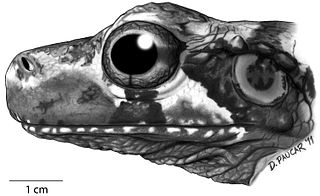The Honduran brook frog is a species of frog in the family Hylidae endemic to Honduras. Its natural habitats are subtropical or tropical moist lowland forests, subtropical or tropical moist montane forests, and rivers. Scientists have seen it between 90 and 1400 m above sea level in Honduras in rainforests.

Osteocephalus helenae is a species of frog in the family Hylidae. It is widely distributed in the Amazon Basin and is known from the lowlands of Bolivia, Peru, Brazil, Colombia, Venezuela, Guyana, and French Guiana. The specific name helenae honors Helen Beulah Thompson Gaige, an American herpetologist. Common name Helena's [sic] treefrog has been proposed for it.
Hyloscirtus alytolylax, called the babbling stream frog, babbling torrenter, or tadapi tree frog in English, is a species of frog in the family Hylidae found in Colombia and Ecuador. Its natural habitats are subtropical or tropical moist lowland forests, subtropical or tropical moist montane forests, and rivers. It is threatened by habitat loss. Scientists have observed it in Colombia between 500 and 2159 meters above sea level and in Ecuador between 400 and 2000 meters above sea level.
Linda's tree frog is a species of frog in the family Hylidae found in Colombia and Ecuador between 2000 and 2500 meters above sea level. Its natural habitats are subtropical or tropical moist montane forests, rivers, pastureland, rural gardens, and heavily degraded former forests. It is threatened by habitat loss.
The Rio Chingual Valley tree frog is a species of frog in the family Hylidae found in Colombia and Ecuador. Its natural habitats are subtropical or tropical moist montane forests, rivers, and heavily degraded former forests. Scientists have seen it between 1950 and 2700 meters above sea level.
The Papallacta tree frog is a species of frog in the family Hylidae found in Colombia and Ecuador. Its natural habitats are subtropical or tropical moist montane forests and rivers. Scientists have seen it between 1950 and 2660 meters above sea level in the Cordillera Oriental. It is threatened by habitat loss.
The Pilalo tree frog is a species of frog in the family Hylidae endemic to Ecuador. Its natural habitats are subtropical or tropical moist montane forests and rivers. It has been observed between 2300 and 2600 meters above sea level. It is threatened by habitat loss.

The Manaus slender-legged tree frog is a species of frog in the family Hylidae found in Bolivia, Brazil, Colombia, Ecuador, French Guiana, Guyana, Peru, Suriname, and Venezuela. Its natural habitats are subtropical or tropical dry forest, subtropical or tropical moist lowland forest, moist savanna, rivers, intermittent freshwater marshes, and canals and ditches. It is threatened by habitat loss. It is also reported to produce Bufotenin.
Hyloscirtus tigrinus is a species of tree frog native to Colombia and Ecuador. It can be found in elevations of up to 3000 meters up in the Andes Mountains. Scientists have observed the frog sitting on vegetation approximately .5 m above ground level.
Dendropsophus shiwiarum is a frog in the family Hylidae. It is endemic to Ecuador and Colombia. Scientists think it may also live in nearby parts of Peru.
Mareku's tree frog is a species of frog in the family Hylidae. It is endemic to Indonesia. Scientists have seen it in the Wondiwoi Mountains in Papua Province.
Scinax montivagus is a frog in the family Hylidae. It is endemic to Brazil. It is known solely from its type locality in the Chapada Diamantina in the Espinhaço Range.
Dendropsophus frosti, the acre tree frog, is a frog in the family Hylidae. It is endemic to in South America. Scientists have seen it at two sites, one in Colombia and one in Peru.
Tepuihyla obscura is a frog in the family Hylidae endemic to Bolivar State in Venezuela. Scientists have seen it near summits in the Chimantá Massif, between 1800 and 2600 meters above sea level.
Litoria christianbergmanni is a frog in the family Hylidae. It is endemic to Indonesia and has been found in the Fakfak Mountains at 860 meters above sea level.
Sphaenorhynchus mirim is a frog. Scientists have seen it in one place: Fazenda Gemada in Brazil.
Charadrahyla esperancensis, the Esperanza tree frog, is a frog in the family Hylidae. It is endemic to Mexico. Scientists have seen it in Oaxaca at 1640 meters above sea level.
Osteocephalus vilarsi is a frog in the family Hylidae endemic to the state of Amazonas in Brazil and the state of Amazonas in Venezuela. Scientists think it might also live in Colombia. This frog lives in white-sand forests.

Osteocephalus cannatellai is a frog in the family Hylidae endemic to Ecuador and Colombia. Scientists have seen it between 200 and 1290 meters above sea level.
Bromeliohyla melacaena is a frog in the family Hylidae endemic to Honduras. Scientists have observed it in pine forests between 1370 and 1990 meters above sea level.



